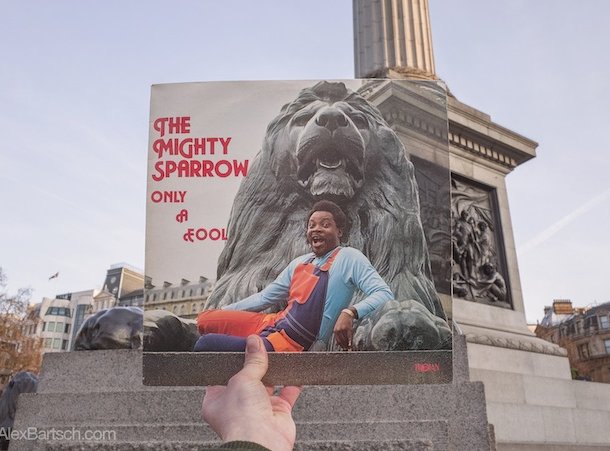Retracing Reggae Record Sleeves in London is a project by French-born, Brixton-based photographer Alex Bartsch that takes a closer look at reggae record covers photographed in London between 1967 and 1987.



[Above: Brixton Cat LP by Joe’s All Stars, Trojan Records, 1969]

[John Holt, 2000 Volts of Holt (Trojan Records, 1976), rephotographed in Holland Park, London W14, 39 years later]
After researching various reggae LPs and twelve-inches from his record collection, Bartsch has rephotographed more than 40 sleeves in their original locations, holding them up at arm’s-length to blend in with their surroundings, decades later.

[Various Artists, Harder Shade of Black (Santic, 1974), rephotographed in Hackney Downs, London E5, 42 years later]
Presented in this way, the images represent the passing of time, and provide a fascinating insight into the history of reggae music in London, inviting the viewer to rethink the relationship between the city and its musical heritage.

[Al Campbell, Rainy Days (Hawkeye, 1978), rephotographed in King Edward VII Park, London NW10, 38 years later]
A Kickstarter campaign to publish the photographs in a book will run from 25 October to 6 December 2016.

[Smiley Culture, Cockney Translation (Fashion Records, 1984), rephotographed on Plough Road, London SW11, 32 years later]
Alex Bartsch:
The idea first came to me when I bought the Brixton Cat LP by Joe’s All Stars (Trojan Records, 1969). I live in Brixton and took the record down to the market where the cover photo was shot, holding it up and rephotographing it at arms length, matching up the LP to the background.
The second cover was Smiley Culture’s Cockney Translation 12″, which was photographed in Battersea. From then on, I was hooked.
To date I have located more than 40 covers. Some were easy to find while others took months of detective work. I cycled all over the city, from Penge in southeast London to Harlesden in the northwest.
There were wild goose chases, and some unexpected finds. It’s been a great adventure, and has painted an interesting map of London’s reggae music heritage.

[Carroll Thompson, Hopelessly in Love (Carib Gems, 1981), rephotographed on Milton Avenue, London NW10, 34 years later]
Alex Bartsch:
The image on a record cover usually remains within defined borders, instantly recognisable as a record cover, but not so much as a location.
Approaching the scene from a wider angle and revealing the cover’s surroundings brought me, and will hopefully bring others, closer to the time and place of the original photo shoot.

[Moodie, Early Years (Moodie Music, 1974), rephotographed on Downhills Park Road, London N17, 41 years later]
Photographer Alex Bartsch checks out the places and spaces depicted on classic London reggae LP covers.
So much of London’s vibrant music history has revolved around the profound impact of Jamaican reggae and dub. Now, photographer Alex Bartsch is exploring reggae’s musical heritage through some of its most memorable record sleeves. In doing so, he reveals fascinating insights into the changing urban landscape of London.
As Bartsch puts it, finding some of the locations of the original shots was a psycho-geographic experience in itself: “To achieve some of these shots, I had to hitch a boat ride across Regent’s Canal, climb onto a roof top near Old Street, ask to enter someone’s front room in Hampstead, access a backyard in Wembley and venture on to the Westway in West London.” You can pledge to the projcet’s Kickstarter here.

From Brixton to Haringey, Alex Barsch has rephotographed more than 40 record sleeves





You must log in to post a comment.